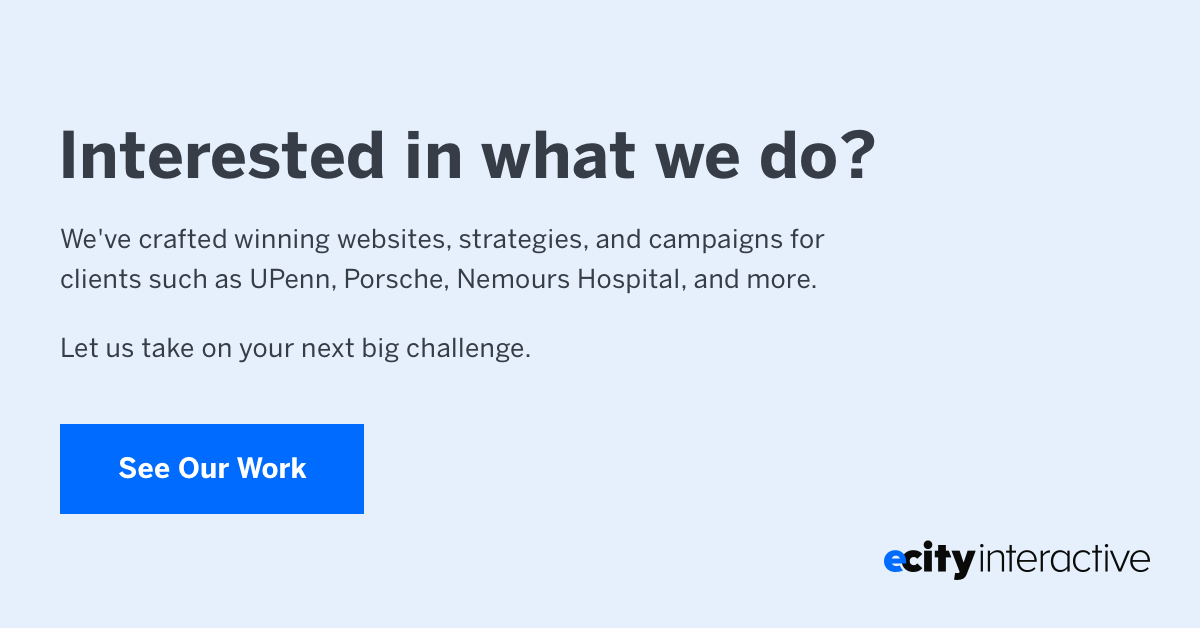Editor’s Note: This blog post is the third and final post in a series resulting from a conversation between eCity Interactive and Chris Barrows of NYU and Joel Renner of George Washington University. See the first post on engaging young alumni here, and the second post on higher ed social media here.
In higher education, it can sometimes feel taboo to talk about branding. While you may be uncomfortable viewing your college or university as a “brand,” it’s important to consider that every institution has an image and reputation to uphold.
We recently spoke with two higher ed pros, Chris Barrows of New York University and Joel Renner of George Washington University, about how schools are portraying themselves actively and passively. Barrows and Renner offered up their thoughts on what’s missing in the world of higher education branding and how schools can stand out in a crowded landscape. The result was an insightful conversation that gave way to three key lessons to keep in mind as you navigate the complicated world of branding in higher ed.
Great brands are built from the inside out
It’s not enough for the social media or marketing team to sit down and have a discussion about what the brand of the university should be. According to Barrows and Renner, this discussion needs to happen at a much higher level. “There are schools that have a strong brand, and it comes from a president or a vision that the university is using,” says Renner.
One such example is Cornell University. Renner recalls that every student he’s met from Cornell has a sense of community and pride in the University that’s lacking at other schools. This isn’t necessarily a testament to the marketing team at Cornell as much as it is to the school’s commitment to living its values and serving its students.
“Your brand has to be the reason students are attending your school,” says Renner. Presidents may come and go, but your school’s reputation will outlast them all. A great brand is one that comes directly from the students, faculty, and alumni. They are the greatest testament to your university’s success.
A brand is what sets you apart
Lately, many schools have fallen into the trap of having uniform messaging that could belong to any college or university. Renner likened this to businesses aiming to be, “the Amazon or the Apple or the Google of their industry.” “Those are actually three very different examples when you look at them, so people will pick the one that fits as close to what they do as possible,” says Renner. However, it’s important for higher education professionals to dig deeper and do some research into what students actually think of their school.
According to Barrows and Renner, it’s easy for administrators to get caught up in the competition and forget to zero in on their own strengths as a university. “Schools spend a lot of time and money when they haven’t even looked at themselves and found the best stories that they have,” says Renner. Instead of looking to the competition for answers, Barrows suggests focusing on your audience and how you can better serve them. “Focus on what makes you unique, and that is the people who attend your university or are interested in attending your university,” he says.
When you start working to serve your audience first and foremost, it won’t matter as much what the competition is doing or who tried what marketing tactic first. These approaches will get your school publicity for being new and innovative, but the real goal is to serve your audience and attract the right prospective students. “If you like where your school is going, and if you like the direction that your alumni are taking when they leave, then it’s fostering those stories because you’re going to attract people that want to do the same,” says Renner. These types of stories are more valuable than any publicity stunt or flashy write-up.
You can never fully control your brand
When it comes to branding, Barrows says not to overthink it. “A brand is defined by the people and what they think of you.” It’s impossible to fully control what people think of your school. Rather than striving to create the perfect brand image, schools need to listen to feedback from prospects, students, and alumni.
At George Washington University, Renner is doing this by cultivating a student-driven community of feedback and improvement. “We want students to understand how much staff and faculty care,” says Renner. If students find examples of staff or faculty not caring, Renner wants them to feel comfortable pointing it out so the issue can be rectified.
On the flip side, “there are students that don’t care about the brand or the school,” says Renner. How does he handle students who’ve decided to disparage the school despite the consensus that everyone is working to make it a better place? “If it’s a good enough [online] community and somebody says something bad, then it’s self-policed,” says Renner. This is the ultimate goal of branding – to build an authentic reputation people are ready and willing to defend.
A brand is so much more than a logo or a flashy website design. It’s the mission of your college or university and the people who live that mission every day. Higher education branding is an ongoing and highly collaborative process. Prospects, students, faculty, and alumni need to trust that you have their best interests in mind and that you hear the feedback they’re offering up. If you can successfully communicate this message of community and make your audience feel heard – you’ll have an authentic brand that will withstand even the worst critics.




